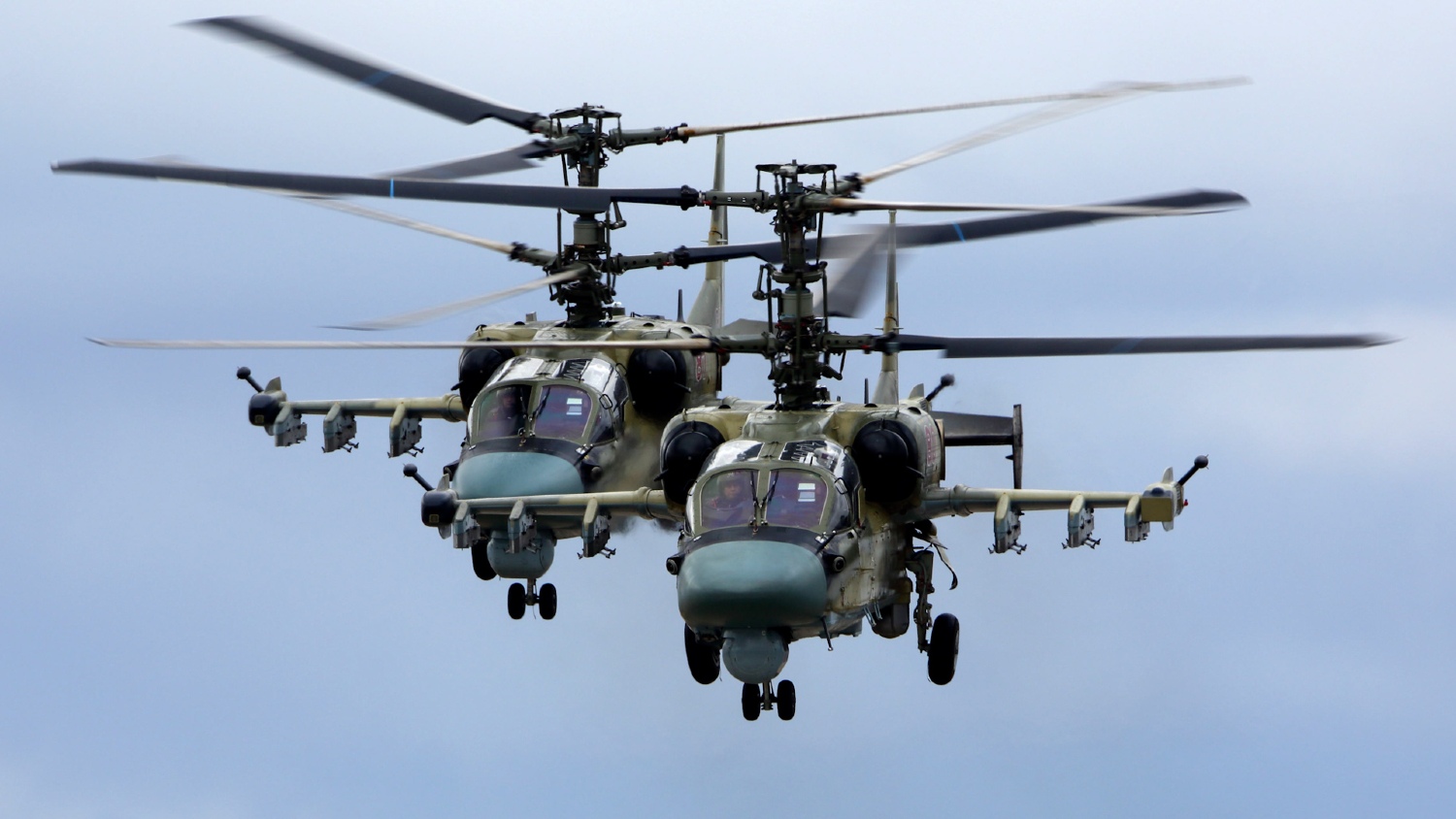Russia Records 1st UAV Shoot Down By Missile-Armed Helicopter; Heralds New Era In Drone-To-Drone Combat

On October 23, Rostec state corporation reported that a Russian Kamov Ka-52 helicopter, for the first time, shot down a Ukrainian drone using a Vikhr-1 anti-tank guided missile (ATGM).
Drone shoot-downs using a missile in air-to-air engagements have been recorded, though they are still rare. Israel and its allies are known to have shot down Iranian cruise missiles and kamikaze drones using air-to-air missiles during the recent Iranian retaliatory attacks against Israel.
It’s possible that Ukrainian and Russian fighter pilots, too, have such drone kills to their credit. However, shooting down a drone while flying a fighter with powerful onboard radar and electro-optic sensors isn’t as challenging as shooting down a drone from a helicopter sans any detection and tracking sensor.
The author cannot recall a drone being shot down by a helicopter using a missile under combat conditions, though it has possibly been demonstrated in trials.
The circumstances under which the Ka-52 engaged the drone are not known, but Russia is known to have deployed armed helicopters to shoot down long-range Ukrainian drones.
AfriPrime App link: FREE to download...
https://www.amazon.com/Africircle-AfriPrime/dp/B0D2M3F2JT
Vikhir (Whirlwind) Missile
The Vikhr (Whirlwind) missile is designed to destroy ground-based maneuverable armored vehicles equipped with dynamic protection units, as well as medium-speed air targets (helicopters, attack aircraft, and drones).
“The Whirlwind eliminated the aerial target with a precise hit, despite the small size of the UAV and its very low thermal radiation due to its electric motor. This is the first known example of such a munition being used against a drone,” Rostec said in a statement published on its Telegram channel.
The Vikhr uses Semi-Active Laser Homing (SALH) guidance. As such, it can engage a target without any thermal or radar signature.
The missile reportedly has a maximum speed of 610 meters per second. Its launch range can vary from 800 m to 10,000 m, and its launch height can vary from 10m to 4000 m.
The supersonic missile is optimized for engaging armor. It reportedly features a powerful tandem HEAT warhead weighing 12 kg that can penetrate 1200 mm of homogeneous armor, defeating even the most protected parts of the hull. In the case of ERA, Vikhr is reportedly capable of penetrating up to 750 mm thick homogeneous armor behind the reactive armor.
Besides armor, Vikhrs are used to destroy firing points, and camouflaged and protected objects.
Drone Interception Challenge
A drone is a much smaller target than an armored vehicle. Its flight path can vary abruptly, making the point of interception difficult to predict. Therefore, engaging a drone with an ATGM requires precision and very responsive controls.
Rostec’s holding company, High-Precision Systems, developed the Vikhr missile, which is produced by the Kalashnikov Group of Companies.
The Vikhr’s main launch platform is the Ka-52 helicopter, which can be armed with 12 Vikhir transport and launch containers. The missile can also be launched by Su-25 attack fighters.
Hospital Management Platform SaaS.. Hospital and Patients management system perfect for all medicals.
Partnership/Agent Needed. Earn As You Go on monthly basis.
Contact Admin: admin@healthdata101.com
+++++++++++++++++++++++++++++++++++++++++++++++++++++
Vikhr Modernisation & Drone Launch Adaptation
In July, Rostec announced that Kalashnikov’s concern is increasing the missile’s range and improving its warhead. Kalashnikov also planned to adapt the missile for use by armed drones.
Russia already has an ATGM that can be launched from an armed drone, Kh-UAV.
The Kh-UAV missile, which has been in development since at least 2021, is a Kornet-D ATGM variant, adapted for launch from attack drones and helicopters at a distance of up to 8 km.
Like the Vikhr, the Kh-UAV uses SALH guidance. The missiles land on targets illuminated with a laser beam.
Russia has now successfully demonstrated the Vikhr’s ability to engage small airborne targets like drones. Russia is also known to be adapting the Vikhir for launch from drones.
It’s possible that Russia’s Orion could soon be fielded with the drone-launched Vikhr variant, which has adequate range and precision for air-to-air engagements and air-to-surface strikes.

Ukrainian Drone Threat
Ukrainian long-range drones currently pose a big threat to Russian military airbases, ammunition dumps, and energy installations.
Many Ukrainian drones that attempt to penetrate Russian airspace are shot down by Russian air defense (AD) systems or downed using electronic warfare (EW). However, some drones inevitably penetrate and strike their targets by saturating Russian defenses.
In addition to AD systems, Russian Ka-52 helicopters have been observed intercepting Ukrainian kamikaze drones. These helicopters patrol known or suspected drone attack routes, leveraging their mobility and firepower to engage drones in mid-air.
This method involves direct engagement, where helicopters use onboard weapons systems to shoot down drones.
The use of helicopters provides operational flexibility. Unlike fixed-wing aircraft, helicopters can hover, making them more effective for sustained engagement with slow-moving or hovering drones. They can also operate in areas where fixed-wing aircraft might be less effective due to lower altitudes or urban environments.
U.S. Boosts Ukrainian Drone Production
Observing the success of Ukrainian drone strikes, the U.S. government recently pledged $800 million for Ukrainian long-range drone production.
This funding marks a pivotal shift in U.S. policy. Instead of supplying long-range missiles, such as ATACMS, which could deplete US inventory and possibly escalate the conflict, the US has chosen to augment Ukraine’s ability to produce its own military equipment.
Ukraine has a proven ability to develop, manufacture, and launch long-range kamikaze drones against Russian targets. The infusion of the US funds will significantly boost Ukraine’s drone warfare ability.
Conclusion
In view of the Ukrainian drone threat, it has become imperative for Russia to provide its armed helicopters and drones with air-to-air capability.
No country can defend all potential targets with AD systems. Before the advent of kamikaze drone warfare, fighter aircraft were used to plug gaps in ground-based air defenses.
Drones’ ability to fly very low and route over urban areas dramatically limits fighter aircraft’s ability to fill the gaps. The inherent asymmetry in deploying expensive manned fighters against cheap drones is resource-draining.
Under the circumstances, the evolution of drone-vs-drone air combat using missiles was inevitable. It appears Russia is well set on the trajectory, and it’s just a matter of time, possibly months, before the world records its first missile kill in drone vs. drone air combat!
AfriPrime App link: FREE to download...
https://www.amazon.com/Africircle-AfriPrime/dp/B0D2M3F2JT
- Questions and Answers
- Opinion
- Story/Motivational/Inspiring
- Technology
- Art
- Causes
- Crafts
- Dance
- Drinks
- Film/Movie
- Fitness
- Food
- Spellen
- Gardening
- Health
- Home
- Literature
- Music
- Networking
- Other
- Party
- Religion
- Shopping
- Sports
- Theater
- Wellness
- News
- Culture
- War machines and policy

